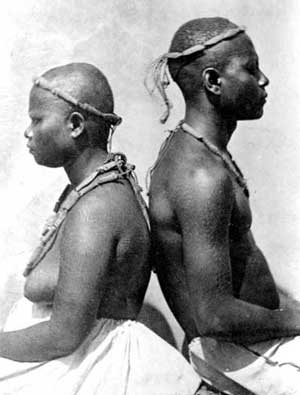

Territory of the Andamanese peoples in the late 19th century
-
The term Negrito refers to several ethnic groups who inhabit isolated parts of Southeast Asia. Their current populations include 12 Andamanese peoples of the Andaman Islands, six Semang peoples of Malaysia, the Mani of Thailand, and the Aeta, Agta, Ati, and 30 other peoples of the Philippines.
Genetically, Negritos are the most distant human population from Africans at most loci studied thus far (except for MC1R, which codes for dark skin).
They have also been shown to have separated early from other Asians, suggesting that they are either surviving descendants of settlers from an early migration out of Africa, commonly referred to as the Proto-Australoids, a term first used by Roland Burrage Dixon in his 1923 book Racial History of Man, or negroids, or that they are descendants of one of the founder populations of modern humans.
The Proto-Australoids’ were an ancient hunter-gatherer people descended from the first major wave of modern humans to leave Africa 50,000 years ago. Characterised by gracile body types, they are thought to have had dark skin colour approaching black and wavy or curly black hair. They had long heads and broad, flat noses just like the inhabitants of Modern day Oceania and Africa.
The proto-Australoids are thought to have begun their exodus out of Africa roughly 100,000 years ago. They are thought to have used a simple form of watercraft to cross the narrow span of water between the Red Sea and the Gulf of Aden.
From there it is hypothesized that they followed a coastal route through south Asia into Southeast Asia. While some individuals made a short oceanic voyage into Australia (50-60 thousand years ago), giving rise to the Australian Aborigines, others continued their coastal migration north into East Asia.
Proponents of a proto-Australoid population wave theorize that remnants of this early founding population may be found today in Southern portion of the subcontinent, Southeast Asia and Oceania. Some have proposed connections to the Ainu of Japan. Genetically, they have been tentatively associated by some authors with mtDNA haplogroup M and Y-chromosome Haplogroup C, the earliest Homo Sapiens lineages thought to have migrated outside of Africa.
Negritos may have also lived in Taiwan, where they were called the “Little Black People”. Apart from being short-statured, they were also said to be broad-nosed and dark-skinned with curly hair. The little black population shrank to the point that, up to 100 years ago, only one small group lived near the Saisiyat tribe.
A festival celebrated by the Saisiyat gives evidence to their former habitation of Taiwan. The Saisiyat tribe celebrate the black people in a festival called Pas-ta’ai.
The word “Negrito” is the Spanish diminutive of negro, i.e., “little black person”, referring to their small stature, and was coined by early European explorers.
Occasionally, some Negritos are referred to as pygmies, bundling them with peoples of similar physical stature in Central Africa, and likewise, the term Negrito was previously occasionally used to refer to African Pygmies.
Many on-line dictionaries give the plural in English as either ‘negritos’ or ‘negritoes’, without preference. The plural in Spanish is ‘negritos’.
According to James J.Y. Liu, a professor of comparative literature, the Chinese term Kun-lun means Negrito.
Great Andamanese is a collective term used to refer to related indigenous peoples who lived throughout most of the Great Andaman archipelago, the main group of islands in the Andaman Islands; and also to their present-day descendants, living since 1970 on Strait Island.
The Great Andamanese were originally divided into ten major tribes, with distinct but closely related languages comprising one of the two identified families of indigenous Andamanese languages, the Great Andamanese family.
The Great Andamanese were clearly related to the other four major indigenous groups in the Andaman islands, but were well separated from them by culture and geography. The languages of those other four groups were only distantly related to those of the Great Andamanese and mutually unintelligible; they are classified in a separate family, the Ongan languages.
Once the most numerous of the five major groups in the Andaman Islands, with an estimated population between 2,000 and 6,600 the Great Andamanese were heavily decimated by diseases, alcohol, colonial warfare and loss of hunting territory.
Only 52 remained as of February 2010, and the tribal and lingusitic distinctions have largely disappeared, so they may now considered a single Great Andamanese ethnic group with mixed Burmese, Hindi and aboriginal descent.
The Great Andamanese are classified by anthropologists as one of the Negrito peoples, which also include the other four aboriginal groups of the Andaman islands (Onge, Jarawa, Jangil and Sentinelese) and a few other isolated populations of East Asia. The Andaman Negritos are thought to be the first inhabitants of the islands, having emigrated from the mainland tens of thousands of years ago.
Until the late 18th century, the Andamanese peoples were preserved from outside influences by their fierce rejection of contacts (which included killing any shipwrecked foreigners) and by the remoteness of the islands. Thus the ten Great Andamanese tribes and the other four indigenous groups are thought to have diverged on their own over the course of millennia.
Today only two tribes (Jeru and Bo) remain in significant number; the Kari tribe was on its way to extinction. There are still a few people (all elderly) with partial Kora and Pucikwar descent, but they identify themselves as either Jeru or Bo.
However, the cultural and linguistic identities of the individual tribes have largely been lost; their members now speak mostly Hindi or a mixed language, a Great Andamanese creole.
Although the Great Andamanese on Strait Island still obtain some of their diet from hunting, fishing and gathering, they now consume rice and other Indian food, and are dependent on support by the Indian government for survival. They now practice some agriculture, and have established some poultry farms.
Filed under: Uncategorized
